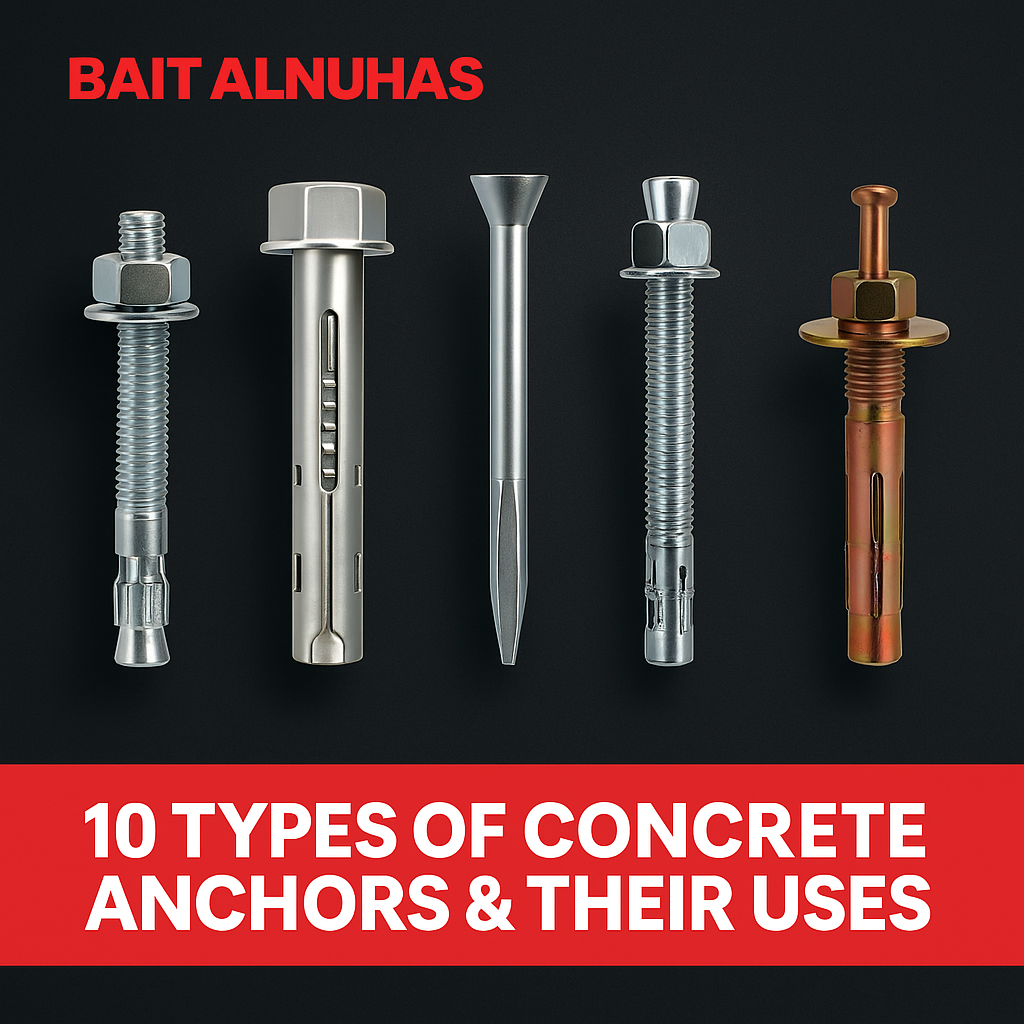10 Types of Concrete Anchors & When to Use Them
Discover 10 essential types of concrete anchors, including wedge, sleeve, and chemical anchors. Learn when to use each type for strength, safety, and proper load support.
PRODUCT-SPECIFIC


Introduction
Whether you're mounting heavy equipment, securing structural elements, or installing fixtures in concrete, choosing the right type of anchor is crucial for safety and performance. Concrete anchors come in various designs, each engineered for specific loads, materials, and applications. Using the wrong one can lead to failures, safety risks, and increased costs.
In this blog, we’ll walk you through 10 common types of concrete anchors, their best use-case scenarios, and what makes each one ideal for certain projects.
Understanding Concrete Anchors and Their Role
Concrete anchors are fasteners specifically designed to connect objects or structures to concrete surfaces. These anchors ensure secure and reliable installation, especially in construction, HVAC, plumbing, electrical, and industrial settings.
What Makes a Good Concrete Anchor?
A good concrete anchor must resist pull-out forces, shear loads, and vibration. Factors such as anchor type, base material, and installation method play a major role in its performance.
10 Common Types of Concrete Anchors & Their Uses
Let’s explore the most widely used concrete anchor types, how they work, and when to use them.
1. Wedge Anchors
Wedge anchors expand when the bolt is tightened, creating a strong hold in solid concrete. They're ideal for heavy-duty static loads and structural applications like base plates and machinery.
Best for: Structural steel, heavy machinery, racking systems
2. Sleeve Anchors
Sleeve anchors expand a sleeve against the wall of the hole, providing a reliable grip in concrete, block, or brick. They're versatile and easy to install.
Best for: Medium-duty applications, handrails, signs, shelves
3. Drop-In Anchors
Drop-in anchors are internally threaded anchors designed for flush, permanent installations. They require a setting tool for expansion.
Best for: Overhead supports, suspended ceilings, threaded rods
4. Lag Shield Anchors
Lag shields are used with lag bolts to anchor into concrete or masonry. The shield expands when the bolt is driven in, locking the bolt in place.
Best for: Light-to-medium loads in brick, concrete, or stone
5. Strike Anchors
Strike anchors are hammer-driven and expand once inserted. They provide fast, one-step installation for heavy loads.
Best for: Pallet racking, fencing, support brackets
6. Concrete Screws (Tapcon)
Concrete screws cut threads into the base material, making them great for lighter-duty applications with quick installation and removal.
Best for: Electrical boxes, light fixtures, temporary installations
7. Plastic Anchors
Plastic anchors are designed for very light loads and usually paired with screws. Not ideal for high-load applications.
Best for: Hanging pictures, light-duty wall hangings on masonry
8. Epoxy Anchors (Chemical Anchors)
Epoxy or chemical anchors use adhesive to bond threaded rods or rebar into drilled holes. They offer exceptional load capacity and corrosion resistance.
Best for: Structural retrofitting, rebar connections, seismic zones
9. Hammer-Set Anchors
These anchors are installed by hammering the pin into the anchor body, causing expansion. They’re simple and best for medium loads.
Best for: Fixtures that won't experience heavy vibration or load changes
10. Toggle Bolts for Masonry
Toggle bolts use spring-loaded wings that open once inserted, anchoring behind the wall surface. They're not for solid concrete but can work in hollow concrete blocks.
Best for: Hollow block walls, light-to-medium loads
Choosing the Right Anchor for Your Application
With so many options available, choosing the right concrete anchor depends on several factors including:
Load capacity requirements
Base material (solid concrete vs. hollow block)
Installation environment (indoor, outdoor, corrosive)
Ease of installation and removability
Always refer to the manufacturer's data sheets and engineering specifications for safety-critical applications.
Common Use Cases by Industry
Concrete anchors are used across various industries. Here's a quick breakdown:
Construction: Wedge, epoxy, and drop-in anchors for structural steel, equipment, and framework.
MEP (Mechanical, Electrical, Plumbing): Sleeve anchors and Tapcons for brackets, conduits, and HVAC supports.
Retail & Warehousing: Strike and wedge anchors for racking systems.
DIY & Residential: Plastic anchors and concrete screws for light installations.
Conclusion
Concrete anchors play a crucial role in ensuring structural stability and safety. Selecting the right type is essential not only for performance but also to meet safety regulations and industry standards. From light-duty plastic anchors to heavy-duty epoxy systems, each type has its place in a well-planned installation.
Call-to-Action
Looking for high-quality concrete anchors in bulk? Contact Bait Alnuhas today — the UAE’s trusted fastener supplier for construction, MEP, and industrial needs.
